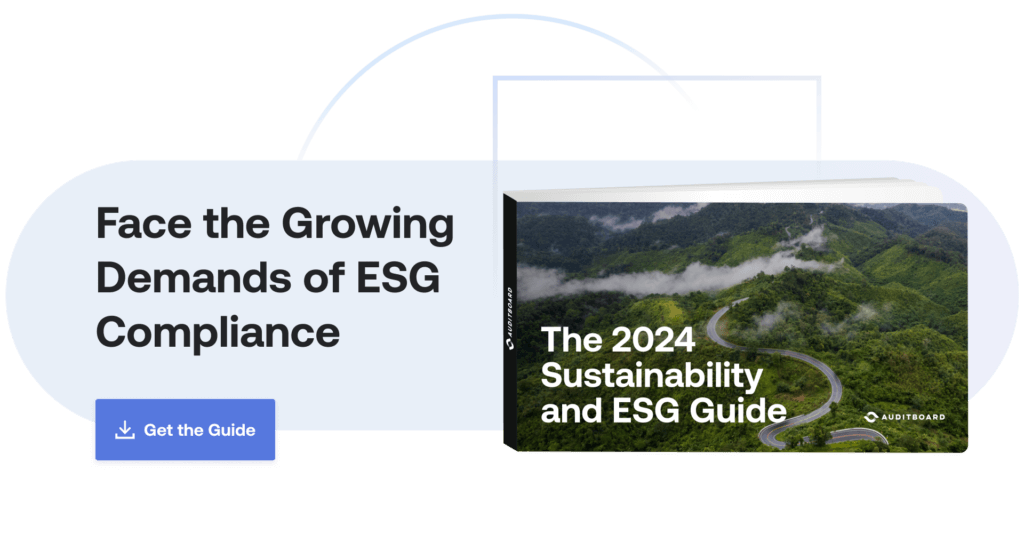
November 9, 2024 • 7 min read
6 Steps to Perform an ESG Materiality Assessment
As the level of scrutiny over sustainability claims and reporting continues to intensify, organizations must prepare to assure their ESG reporting data is accurate and reliable. This will involve identifying and engaging the right individuals and teams to lead reporting efforts, prioritizing ESG efforts by materiality, integrating ESG into the business’s overall enterprise risk management strategy, and preparing the business for ESG audits.
Performing an ESG materiality assessment allows the business to identify and assess material topics to disclose and create a reporting strategy. Before beginning a materiality assessment, executive leadership should form an ESG steering committee. This important group of individuals will lead the essential research and development to determine what materiality means for your business, as well as oversee implementation of ESG strategy and risk management. As such, the steering committee might include an individual who also sits on the financial disclosure committee, or even be a subcommittee or working group within the financial disclosure committee.
Download the full Sustainability and ESG Guide for a deep dive into the subject, and continue reading for:
- Differences between single vs. double materiality
- How to perform an ESG materiality assessment
- A sample double materiality matrix
Single Versus Double/Impact Materiality
Some frameworks and standards require companies to apply the principle of materiality in order to determine what they will disclose. Within the sustainability world, there exists the concept of single versus double materiality when it comes to reporting disclosures:
- Single Materiality: traditional financial materiality, where a disclosure is considered material if it can affect the company’s bottom line — i.e., what is material to the business, aka “outside-in.”
- Double or Impact Materiality: a disclosure is material if it is material from an “impact” perspective (e.g. affects employees, customers, vendors, environment), a financial perspective (e.g. investors, creditors), or a combination of both — what is material to society or the planet, aka “inside-out.”
[screenshot of image https://go.auditboard.com/rs/961-ZQV-184/images/AB-EB-ESG-Planning-and-Scoping.pdf]
A company’s choice to approach its ESG program from a single or double materiality perspective is foremost influenced by regulatory requirements and alignment with sustainability frameworks and standards. Another useful resource to consider is the SASB Materiality Map, which identifies and ranks sustainability issues likely to affect the financial condition or operating performance of companies across different industries.
6 Steps to Perform an ESG Materiality Assessment
The following are the basic steps for performing an ESG materiality assessment:
- Research and benchmark against industry and peers
- Define materiality for your business
- Identify potential material topics
- Interview individual stakeholders
- Analyze and rank material issues by priority (see materiality matrix below)
- Determine material topics to disclose
- Research and benchmark against your industry and peers. Research the frameworks, standards, and ratings that apply to your company and its peers. See Chapters 1 and 2 for links to resources.
- Define materiality for your business. When you have gathered enough information, define what materiality means for your business. The determination of a single or double materiality approach should take into account your company’s jurisdiction, future regulations, and what industry peers are doing.
- Identify potential material topics. Create a list of material topics, indicating which topics fall under single or double materiality (if pursuing double materiality).
- Interview key stakeholders. In addition to board members, executive management and business process owners, key stakeholders may also include investors, employees, customers, regulators, and external audit consultants.
- Analyze and rank material issues by priority. Following your stakeholder engagement, compile your results in a materiality matrix to help visualize, organize, and rank key issues by priority and ESG topic.
- Determine material topics to disclose. Leverage your materiality matrix to engage in conversations with executive leadership and the board to determine the following:
What material topics to disclose
Sustainability objectives
How sustainability objectives relate to overall business strategy - What material topics to disclose
- Sustainability objectives
- How sustainability objectives relate to overall business strategy

The future of more responsible sustainability and ESG reporting starts with informed and proactive steps today. For more insight on navigating the challenges of new and upcoming ESG disclosures, AuditBoard’s Sustainability and ESG Guide provides actionable solutions to ensure a resilient and effective ESG program. Seize the opportunity to stay ahead — download the full guide to uncover essential tips and best practices for shaping your ESG strategy.
You may also like to read


NIST CSF 2.0: What IT compliance managers need to know in 2025

Building resilience with IAM: Unifying access, risk, and compliance

ISO 27001 risk assessment: A practical guide for IT compliance managers

NIST CSF 2.0: What IT compliance managers need to know in 2025

Building resilience with IAM: Unifying access, risk, and compliance
Discover why industry leaders choose AuditBoard
SCHEDULE A DEMO




